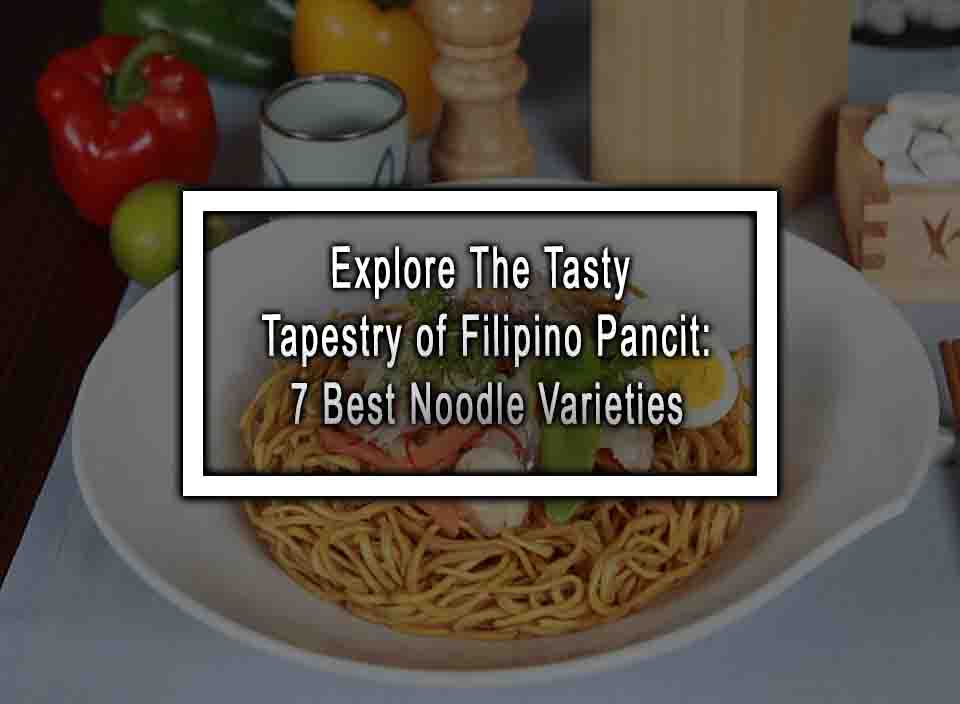Let’s Unravel the Noodle Extravaganza of the Philippines!
Filipino cuisine is a colorful tapestry woven with flavors, textures, and soul-warming comfort foods. Among these, Filipino pancit reigns supreme as a staple dish that symbolizes long life and good health. It’s a must at celebrations, symbolizing the hopes for a long and prosperous life, and its versatility is a testament to the rich culinary history of the Philippines. With a myriad of regional variations, each pancit dish offers a unique taste experience that is both familiar and exciting. So, put on your culinary explorer hat as we embark on a delectable journey through the incredible world of Filipino pancit varieties!
1. Pancit Bihon
The quintessential Filipino noodle dish, Pancit Bihon, is a sautéed masterpiece often featuring rice vermicelli noodles, a medley of vegetables, chicken, pork, or shrimp, and seasoned with soy sauce and calamansi juice. Light and flavorful, it’s a beloved classic that never fails to satisfy.
2. Pancit Canton
For those who love their noodles with a bit more chew, Pancit Canton is the thick and savory star of the show. Often compared to lo mein, this dish uses egg noodles and is generously tossed with meats and vegetables, drenched in a rich soy-based sauce.
3. Pancit Palabok
A festive riot of colors and textures, Pancit Palabok is a dish that’s as pleasing to the eye as it is to the palate. Its rice noodles are covered in a golden shrimp sauce and topped with a cornucopia of garnishes, including crushed chicharron, boiled eggs, shrimp, and green onions.
4. Pancit Malabon
Named after its city of origin, Pancit Malabon showcases a bolder flavor profile with thick rice noodles coated in a fishy sauce made from shrimp and crab fats. It’s garnished with an array of seafood, hard-boiled eggs, and sometimes even oysters, reflecting the city’s coastal seafood bounty.
5. Pancit Habhab
Street food aficionados, rejoice! Pancit Habhab, sometimes called Pancit Lucban, is a special dish served on a banana leaf and traditionally eaten without utensils. Its miki noodles are doused in a vinegar-based sauce and tossed with vegetables and meat, offering a tangy and savory eating experience.
6. Pancit Lomi
Perfect for rainy days, Pancit Lomi is a soupier choice with its thick egg noodles soaking in a hearty and thick broth. The lomi gets an extra layer of richness from beaten eggs and is typically garnished with meat and vegetables, providing comfort in a bowl.
7. Pancit Molo
Breaking away from the noodle-centric pack, Pancit Molo is a soup with wonton dumplings filled with ground pork, chicken, or shrimp, swimming in a light broth. It’s often enjoyed with a sprinkle of green onions and garlic, and it pays homage to the Filipino love for dumplings.
Looking for Filipino delicacy? just click here.
From Wok to Wonderland: The Endless Charm of Filipino Pancit
In the lively landscape of Filipino cuisine, pancit dishes offer an eclectic mix of flavors and textures that cater to every palate. From the simple and light Filipino Pancit Bihon to the sumptuous and hearty Filipino Pancit Lomi, each variant tells a story of cultural exchange, regional ingredients, and shared moments around the table. As we wrap up our noodle-filled expedition, it’s clear that the Filipino tradition of pancit is more than just about feasting—it’s about celebrating life, togetherness, and the myriad strands that weave Filipinos together, both at home and across the globe.
Filipino Pancit FAQs
Here are the most common questions about Filipino Pancit:
1. What is the origin of Pancit?
The introduction of noodles to Filipino cuisine is attributed to Chinese traders and immigrants who settled in the Philippines centuries ago. Over time, Filipinos have adapted noodle dishes to their local tastes and ingredients, making Pancit a unique and quintessential part of Filipino gastronomy.
2. Are there regional variations of Filipino pancit?
Yes, different regions in the Philippines have their own versions of Pancit, which can differ in terms of the type of noodles, ingredients, and flavors. For example, Pancit Habhab, from Quezon Province, is eaten without utensils and served on a banana leaf. Pancit Molo, from the Western Visayas region, is a soup-like dish with wonton dumplings and chicken broth.
3. What utensils are used to eat Filipino pancit?
Pancit is usually eaten with a fork and a spoon, with the fork used to twirl and lift the noodles while the spoon is used to scoop them up. In a more casual setting, chopsticks may also be used.
4. How do you store and reheat Filipino pancit?
Leftover pancit can be stored in an airtight container in the refrigerator for 3–4 days. Reheat it in a pan over medium heat, adding a little bit of water or vegetable oil to prevent the noodles from drying out. You can also microwave it covered, taking care to stir it occasionally for even heating.












